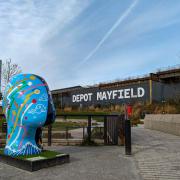Last year’s showers damaged areas of land around England. Martin Pilkington met engineers in Cheshire who have worked hard to repair some local problems.

The view that rolls down into the Weaver valley mixes elements of nature and civil engineering in coexistence for centuries: the Weaver and the Weaver Navigation, the Dutton Viaduct and in the foreground the Trent and Mersey Canal hugging the hill.

But now a muddy gash spoils the scene – temporarily. On September 26th last year the canal was breached near Dutton, scouring a strip of hillside into what looks like the Somme of 1916.


‘As everyone’s aware we had incredible rains through 2012 and that meant in Britain there were five times the usual number of landslips,’ says Paul Brown, the Canal and River Trust’s project manager at the Dutton Breach: ‘A lot of that was down to the water-table rising and not being able to drain away, which is similar to what has happened here. The build up of water saturated the ground and almost liquefied it in the end.’
The Trust’s engineers, warned by an observant member of the public, deployed mitigation measures: ‘We put in stop planks – wooden planks to minimise the length of the canal that would be lost, and brought in clay for emergency damming for a few weeks to hold the water back, but unfortunately once it starts to go it goes,’ he continues. What went was about 1000 tonnes of embankment.
Standing in the bottom of a canal, even if it is empty, makes for nervous moments. Dams of rock and clay either side hold back untold millions of gallons of water. Massive digging machines magnify that feeling of incongruous abnormality. In the clinging mud that only appears on construction sites even Usain Bolt would need a minute to cover the 50m back to the bank.
Then logic returns and two admiring thoughts spring to mind. The first is how technology in the form of those enormous diggers is easing the repair work. The second, how our forebears managed to construct such wonders with little more than picks and shovels. But what takes a score of workers today would have needed a thousand in 1777 when the canal opened.
‘There are about 20 guys here at the moment from May Gurney, working in the compound where materials are being processed, plus down at the bottom of the slope, and here at the line of the canal,” continues Paul. “It’s going as well as can be expected. The aim is to be finished by May.”
Already some of the canal bottom and walls are resurfaced with concrete, and behind the breach what look like giant stairs constructed to act like buttresses for the new embankment.
Before the work on the canal itself could begin several tasks had to be undertaken: ‘We had to approach the landowner and negotiate a land deal with them which gave us access to the compound for the project duration,’ says Paul: ‘And setting up the logistics took time from the official start date to actually getting things going at the canal.’ A temporary road now links the site to the A533, some 12000 tonnes of stone already carried over it to patch the breach and lend the embankment greater stability.
It wasn’t just the repair work that needed managing either: ‘With the damage at Croxton near Middlewich at the same time there were 12 miles of the network isolated, and we had to set up a plan for getting people stranded out onto the Weaver via the boatlift, then via the Ship Canal and back on at Ellesmere,’ Paul explains.
The work is expected to cost about £2.1 million. Helen Hall, press officer with the Canal and River Trust, formerly British Waterways, explains why the timing of the catastrophe was particularly awkward: ‘We became a charity in July and then this happened in September, so the money has come out of our contingency fund.
‘People have been ringing us up offering to help with donations, though, which says something about how they regard the network and this part of it. The Trent and Mersey here is such a popular canal not just for boaters but for walkers too. It is one of the most travelled canals on the network, so getting it back in full use again is important.’
‘We have raised just over £20,000 from donations so far which is fantastic,” says Paul Brown: ‘At the moment we are looking at ways to use some of that money so people have a visible sign of what they’ve paid for.’
The estimate for the work is about £2.1 million though, and an appeal is underway to try to boost the Trust’s funds, with events planned such as open days to demonstrate the scale of what has happened and the work to remedy it. Until that work is complete there is a nasty scar on an otherwise lovely corner of North Cheshire.
Appeal information: Phone: 0303 040 4040 or visit: http://canalrivertrust.org.uk/get-involved/ appeals/help-repair-the-trent-and- mersey-canal-breach



























